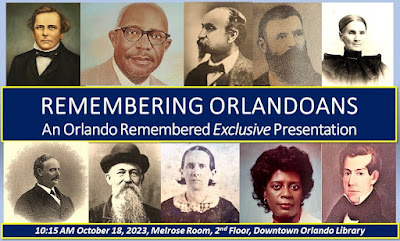Part Three: Orlandoans Remembered
Towering nineteen stories above the skyline in 1971, the
new Continental National American Insurance building on Orange Avenue became a
harbinger for the next generation of buildings in downtown Orlando. Known by
locals as the CNA Building, the impressive skyscraper set an example of
excellence for other downtown high-rises to follow, launching a transformation from
a small southern city into a World-Class Metropolis. Today, one must look closely to view the CNA amidst the busy Orlando skyline. One word often used to
describe this evolution: “Progress.”
As the impressive new CNA building neared completion, an
Orlando landmark several blocks to the north was preparing to refurbish its aging
lobby. Commercial Interior Designer Dan Acito was hired to oversee the
refurbishing of San Juan Hotel’s lobby. A Cincinnati transplant, (not yours
truly), Dan was new to the Central Florida area, having relocated his
established Ohio based business to Winter Park in 1968.
Nearly a decade after his San Juan Hotel remodeling project,
“progress” led to the historic hotel falling victim to the wrecking ball. Acito was
at that time quoted as saying, “we decided if we can’t save the building physically,
we’ll save it visually.” The "we" for whom Dan Acito was speaking was the Orlando Remembered
group, an organization he and a dozen others had organized in the aftermath of
the destruction of the San Juan Hotel.
Organized as a Committee of the Orange County
Historical Society, the mission of the Orlando Remembered group included the
placement of displays in downtown lobbies to memorialize the historic
structures that once graced Orlando’s downtown district. One of the early displays was of the San Juan Hotel, but in June 1985, “250 people helped
unveil the Orlando Remembered memorabilia display of the Bass Hotel – Spanish Restaurant
Block.”
The historic Bass Hotel, operated by Walter C. Bass, an
Orlandoan proclaimed in 1973 to be a “City Father,” was the proprietor of the hotel
which once stood alongside the historic Wilmott Building, on the east side of South
Orange Avenue, where today stands the CNA Building. The Bass Hotel, prior to
Walter acquiring the hostelry, had originally been known as the Astor Hotel.
Orlando’s Astor Hotel of 1914 occupied
the upper two floors of the newly completed Giles-Hovey Building. Constructed by
Orlandoans James L. Giles and C. A. Hovey, their three-story building stood beside
the Wilmott Building, completed around 1914 by the legendary Captain Wilmott.
Historic structures are not merely architecturally pleasing, they remind us too of the remarkable individuals, men and women, who transformed a free-range cow pasture into a vibrant Orlando we know and love today. Remembering their buildings are but one reason for preserving the magnificent structures of yesteryear. They are also memorials to the Orlandoans who built them.
Still, for Orlando anyway,
it seems to have been a challenge – albeit labor of love – for those who have
struggled over the years to preserve the visions of yesteryear. They did so under various Society names, but they all had one thing in common - saving the past.
We may not have an Orlando Historical Society anymore, but we do have individuals still trying to preserve the past. And Orlando Remembered, for nearly 44 years now, has been one such organization doing just that.
If Central Florida history is of interest to you, we at Orlando Remembered invite you to attend our meeting on 18 October 2023. Free and open to the public, this meeting is held on the 2nd floor of the downtown library, where at 10:15 AM on that date, we will present, “Remembering Orlandoans,” an exclusive visual history of some of the remarkable men and women who have participated in the founding and development of Orlando.
Worth repeating is
this, our 10:15 AM event is free and open to the public.










